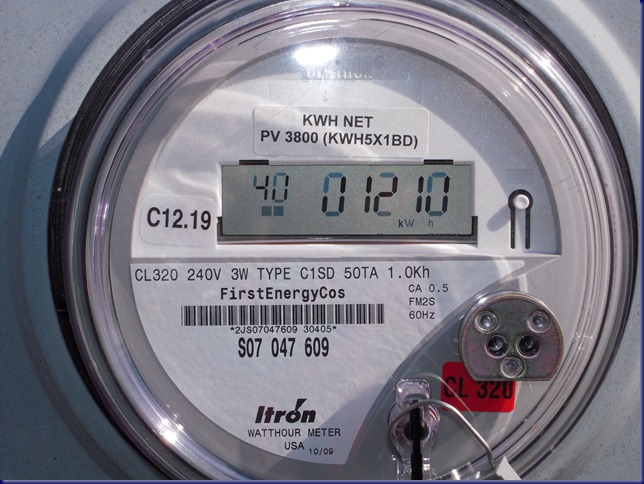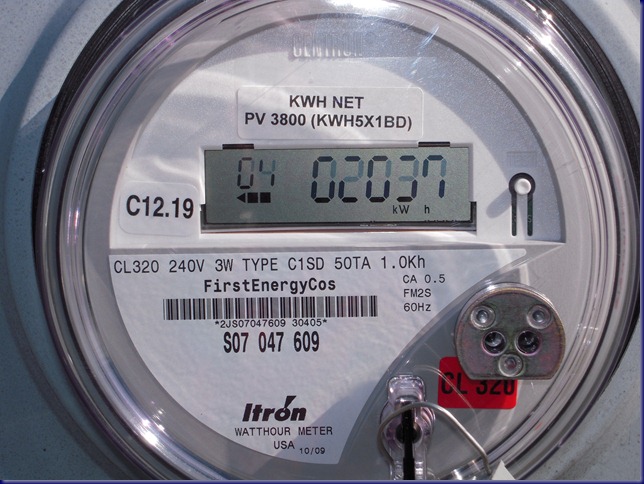Our solar electric system has now been up and running for a little over three months and we have found additional information about the system. Before I start explaining, I want to note that we received our 30% Federal rebate in our income tax return and we are starting our less than five year count down until the system is paid for. The first bit of information has to do with the solar renewable energy credits (SREC). Our system is a 9.89 kV system and we should generate enough electric to qualify for ten SREC’s per year. The SREC’s are sold to electric companies or to Solar Aggregators (companies that contract with electric companies to buy SREC’s at specified prices). You can sell your credits to aggregrators and not have to deal with electric companies.
SREC’s are purchased by electrical utilities in order to meet a state’s Renewable Portfolio Standard (RPS) requirements. Their value is quantified by the state RPS requirements for which they are purchased, the value of the state’s Solar Alternative Compliance Payment (ACP), and the supply and demand of SRECs in a specific state. Because SRECs may be produced in one state and utilized in another, their values can vary dramatically. In other words, they’ll pay you for allowing them to take credit for the clean energy you produce, and they pay you at a rate equal to about 80% of what they’d have pay in fines for not meeting their mandate. The price of an SREC varies greatly depending on the state. When I looked today, April 4, 2010, SREC’s in New Jersey were selling for $665.00 each, Maryland for $325.00 each, Pennsylvania for $250.00 each and Delaware for $225.00 each.
We will receive an SREC for each 1000 kW-hours of energy we produce. I have generated more than 1000 kW-hours of electric back to the grid and should receive one SREC. I called the solar electric company to find out how to sign up to sell my credits. I was told that I could not generate SREC’s that I could sell until the State of New Jersey inspected my system and approved it. That finally happened at the beginning of this past week. The inspection took a little more than an hour. The inspector was very thorough and pleasant and although he couldn’t tell me if I passed or not, I am sure that I did. Once I receive notice from the state that I have passed my inspection, I can start collecting SREC’s.
After our system was installed, we were notified by our electric company that they were going to change our electric meter to one that was calibrated to read electric in and electric out. This took about a month and happened at the beginning of January. At the beginning of February, we received our first electric bill with the new meter. I was kind of disappointed when I saw that we had used 947 kW-hours (kW-h) during that month and that our bill was $164.80. I had received information from our solar installer about the new meters and it was my understanding that the new meters would show two different readings – one for the amount of kW-hours of electric sent into our house from the electric company and the other was the amount of kW-hours of electric sent from our house to the grid. Our bill was to be based on the difference between the two readings. After receiving our bill, I checked our meter and it showed about 1000 kW-hours in and 400+ kW-hours out. When I subtracted the two numbers, it did not equal 965 kW-hours. I called the electric company and complained. They told me that the meter had been read and that our solar electric system had not sent any electric to the grid. She made a notation of the numbers that I had gotten off the meter and said that even if the meter reader made a mistake, it would be made up for on the next billing.
When we received our next bill a month later, it was for $167.00 and I was really hot. I called the electric company and while on hold, I realized that the bill was $164.80 for the last month and $2.20 for the current month. Apparently, our payment and the bill crossed and the payment on the old bill had not yet been credited to our account. The $2.20 charge on the bill is the cost to generate the bill. I also had a credit of approximately 186 kW-hours towards my next bill. I read the meter today (almost a month after the $2.20 bill) and the following were the readings:
The 2037 is the amount of kW-hours that the electric company had sent to our house.
 The 1210 is the amount of kW-hours that we sent back to the grid. The difference (2037-1210) of 827 kW-hours is the amount of kW-hours that I pay for. Since I still haven’t reached the 947 kW-hours that I was billed for two months ago, I should have a $2.20 bill again this month. That is great. What you have to understand about the billing system is that you pay the difference between the kW-hours sent into your home each month minus the amount of kW-hours of electric that you send to the grid each month. My example is based on having an initial bill of 947 kW-hours coming into the house and none going out to the grid. Until I reach a difference of more than 947 kW-hours between the two readings, I should only receive the minimum $2.20 bill.
The 1210 is the amount of kW-hours that we sent back to the grid. The difference (2037-1210) of 827 kW-hours is the amount of kW-hours that I pay for. Since I still haven’t reached the 947 kW-hours that I was billed for two months ago, I should have a $2.20 bill again this month. That is great. What you have to understand about the billing system is that you pay the difference between the kW-hours sent into your home each month minus the amount of kW-hours of electric that you send to the grid each month. My example is based on having an initial bill of 947 kW-hours coming into the house and none going out to the grid. Until I reach a difference of more than 947 kW-hours between the two readings, I should only receive the minimum $2.20 bill.
|
Date |
Start Meter Reading |
Finish Meter Reading |
kW Hours Used |
kW Hours to Grid Start |
kW Hours to Grid Finish |
kW Hours Banked |
kW Hours Billed |
Bill Amount |
|
2/8/2010 |
0 |
947 |
947 |
0 |
0 |
0 |
947 |
$ 164.80 |
|
3/10/2010 |
947 |
1412 |
465 |
0 |
651 |
186 |
0 |
$ 2.20 |
|
4/4/2010 |
1412 |
2037 |
625 |
651 |
1210 |
559 |
|
|
|
total kW Hours Used until 4/4/10 |
827 |
The table above should provide a clearer understanding of the billing process. The first row (starts with “2/8/10”) shows the initial meter reading, the finish reading in kW-hours for electric sent into our home for the time period. the other columns are self explanatory. The row that starts with the date “4/4/10” shows the current readings on the meter as of 4/4/10 (photos above). The last row shows the total amount of kW-hours that we have used to date. It is derived by subtracting the “kW-hours to Grid Finish” from the row that starts with “4/4/10” value from the “Finish Meter Reading” value in the same row. Based on the remainder “827”, we should still get a bill of $2.20 for this month as long as the difference between kW-hours to the Grid Finish” subtracted from “Finish Meter Reading” does not exceed 947 kW-hours.
What I did learn from the inspector is that there are solar electric installers and there are solar electric installers. Some companies are much better than others with their installations. I was impressed with Seabright Solar when they started running conduit up the side of my house and onto the roof for the wires from the solar units to the inverters in the basement. I have seen other systems where the wiring is not in conduit and it looks kind of unfinished to me. I don’t know whether the system not run though conduit will last a longer or shorter time than my system but I am always impressed with a clean looking installation.
© 2010, Herb Segars. All rights reserved.



Hey;
This is an excellent article on the solar energy topic.
Thank you for writing it and sharing it with us.
Chris
https://solar-electricity-panel.com
P.S. I also wrote one article on the topic at:
https://solar-electricity-panel.com/articles/solar-electricity-system-the-frontier-of-sustainable-energy/
thanks for the nice post………